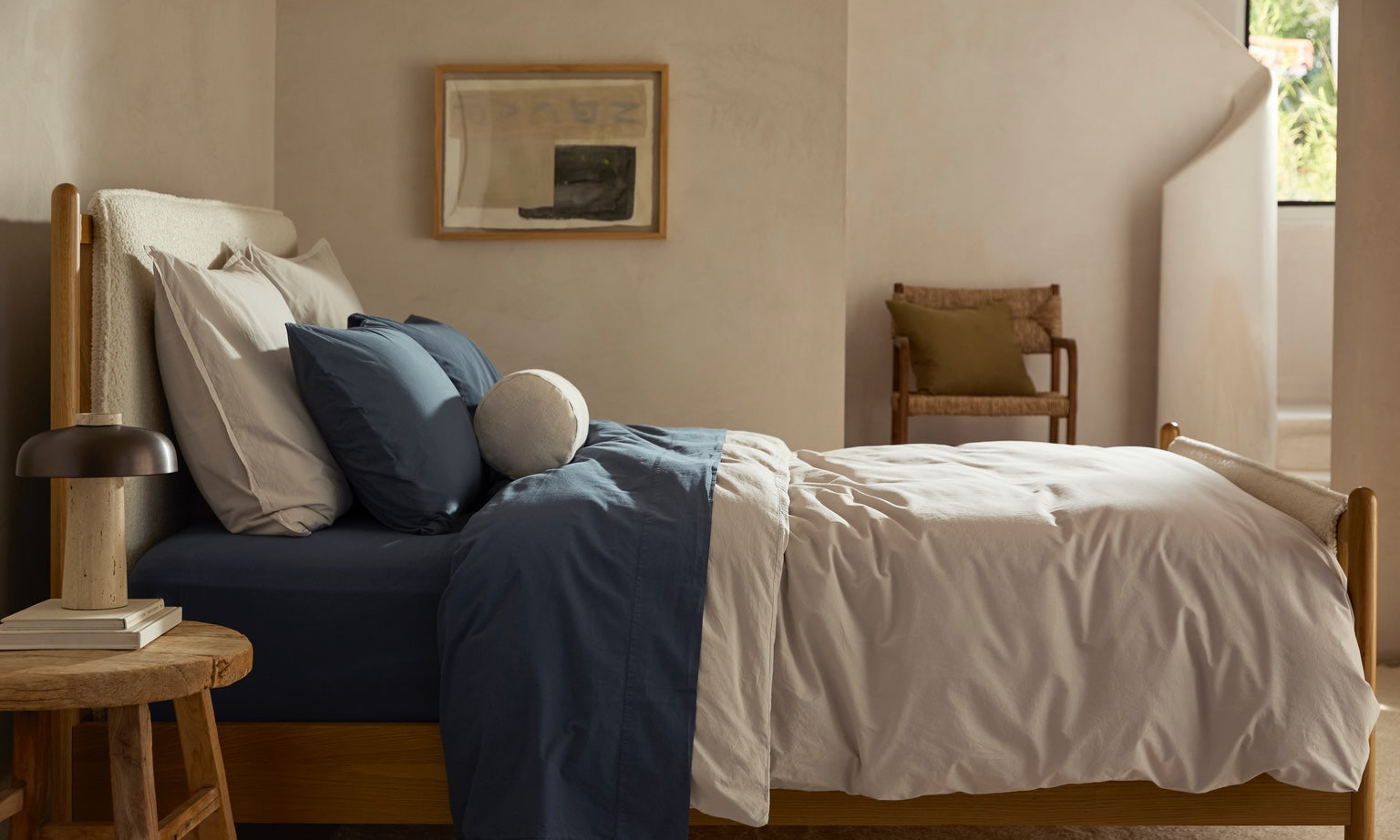
How to Wash and Properly Care for Bedding
Learn how to treat your bedding right with our complete guide on how to care for your sheets, covers, pillows and more.
We all have a vision of a perfect world where laundry washes, dries and folds itself. That’s unfortunately not very realistic. Bedding gets dirty, and worse yet, sometimes spills happen. Anyone who’s ever drank coffee in bed knows of the imminent hazard of such a luxury. Nonetheless, there are ways to keep your bedding clean and pristine while cutting down on wash time.
Care labels are an excellent place to start, but the truth is, proper bedding maintenance requires some additional steps to increase the longevity of your linens. Nobody wants their sheets to become stiff, misshapen or scratchy because they chose the wrong products and the wrong wash cycle.
This guide will help answer all of your bedding care questions, from how to wash bed sheets to the best way to remove even the peskiest stains. Your journey to extra-soft, wrinkle-resistant bed sheets starts here.
How often do I wash my bedding?
What detergent do I use?
What settings and temperature do I use?
How to Wash Bed Sheets, Pillowcases and Duvet Covers
How to Dry Bed Sheets, Pillowcases and Duvet Covers
How to Wash Duvets, Comforters and Pillows
How to Dry Duvets, Comforters and Pillows
How to Remove Stains From Sheets, Comforters, and Other Bedding
How to Protect Your Bedding
Folding and Storing Your Bedding
How Often Do I Wash My Bedding?
Sheets, as well as pillowcases and duvet covers - essentially anything that comes into direct contact with your skin - should be washed every seven to ten days. Failure to wash that often can result in the accumulation of unwanted filth like dead skin cells and dirt, while washing too frequently can wear out your bedding prematurely. It’s also a good idea to rotate in another set during washes to preserve color, elasticity and extend the overall longevity of the product. Plus, the more bedding sets you have, the more freedom you have to wash your sheets when you want to and not when you have to.
If you have decorative bedding on top of your sheets (think quilts, cashmere throws or euro shams), you can wash them a bit less often as long as they don’t come in direct contact with your skin. These types of extra bed layers should be cleaned every three months.
Next up are duvets and comforters. You might technically know how to wash a duvet and how to wash a comforter, but let’s be honest: most of us don’t wash our internal bedding as much as we should. Pillows, duvets and mattress pads should be washed less often than sheets, but still should be cleaned every three to six months. Mattress toppers should be taken to your dry cleaner every six months
You might want to wash your bedding basics every season to get on a solid cleaning schedule.
What Detergent Do I Use?
Detergent is key in how to wash bed sheets properly. This is where you should err on the side of caution. You can get away with using less detergent than the manufacturer recommends, as too much can actually leave your sheets with buildup that will make them stiff, making them smell like mildew and mold. A gentle, liquid laundry detergent is best for your bedding. Never bleach.
To maintain the premium quality of your bedding, avoid harsh liquid and powdered detergents, fabric softeners, dryer sheets and bleaching agents because these coat and weaken the natural fibers. Also, protect your bedding from personal care products and household cleaners that contain alpha hydroxy acids or benzoyl peroxide to prevent discoloration. Acne cream might help your complexion, but it can truly wreak havoc on your linen pillowcase.
If you want to use bleach, make sure it’s non-chlorine. This is a little bit less harsh. Spot-cleaning stains is your best bet to maintain the integrity of the fabric rather than bleaching all together. Vinegar and baking soda can be used to brighten your bedding without damaging it.
What Settings and Temperature Should I Use?
You’ll need to check the label, but as a rule, the best way to wash bedding is with cool water. Some fabrics do well with warm water while others, like mattress pads, are typically dry clean only. You should always avoid hot water because it can degrade the fibers over time and cause shrinking. Always wash bedding on the delicate cycle.
How to Wash Bed Sheets, Pillowcases and Duvet Covers
The first question you might have is can you wash sheets with clothes? While it’s technically doable, it’s not recommended. Brightly-colored clothing can bleed on your sheets, and zippers, hooks and buttons can cause pilling and abrasions.
Wash bedding with other bedding, and keep similar colors and fabrics together. After you’ve gathered your load and checked the tags, these steps will show you how to wash your bed sheets, pillowcases and duvet covers:
Fill the washer with water. While cool water is always recommended, especially with percale and sateen sheets, you can use warm water on linen sheets and essential quilts if you choose.
Add mild, liquid laundry detergent in amounts less than the manufacturer calls for.
Let the soap dissolve before loading bedding into the washing machine.
Add non-chlorine bleach if you’re using it. We recommend OxiClean for removing stains. In this step, you can also add vinegar and baking soda to brighten your bedding.
Wash on a delicate cycle.
For even more detail, check out our guides for how to properly care for percale, linen and sateen.
How to Dry Bed Sheets, Pillowcases and Duvet Covers
The key to a wrinkle-free dry is only filling your dryer half way. This prevents twisted bedding, allowing the fabric to fluff up. Set the dryer to low heat, because overheating can fade colors and cause fibers to become brittle. Use wool dryer balls to reduce static and soften your bedding, not dryer sheets (check out our blog for more information on why dryer balls work best.)
This tip, which we learned from our factory, changed everything for us: Take your sheets out of the dryer a few minutes before the cycle ends, when they’re still the slightest bit damp. This way you can smooth out creases with your hands before they form. Immediately place the sheets on your bed and smooth away wrinkles and finish with a light spritz of linen mist.
How to Wash Duvets, Comforters and Pillows
Duvets, comforters and pillows bring a whole new wealth of questions, like can you wash pillows in the washing machine at all? Will my comforter fit in my top-loader? Like washing bed sheets, you’ll want to check the label before laundering. Some bedding is dry clean only, like most mattress toppers. All of Parachute’s natural down and hypoallergenic down alternative duvets are machine washable.
Washing machine size is important to keep in mind, and many consumer machines won’t fit larger bedding like a king size duvet. If possible, you should use an XL front-loading machine. Duvet inserts and comforters get tangled in smaller machines, and the weight of this type of bedding can throw a top-loading machine off balance. If your machine is the right size, the steps are as follows:
Load your duvet insert, comforter or pillow into your machine.
Add a third of the detergent you’d normally use for a load of this size (the more detergent, the harder it is to wash out). Preferably use detergent made specifically for down or a mild, enzyme-free, all-natural variety.
Wash using cool water and a delicate cycle.
Run the rinse cycle twice to make sure you’ve rinsed out all of the detergent.
For a complete guide on how to wash a duvet click here.
How to Dry Duvets, Comforters and Pillows
Drying duvets, comforters, pillows and thicker bedding like quilts is a little bit more difficult than drying sheets. They take a long time to dry and require regular checking and fluffing. You’ll want to tumble-dry your down and down alternative bedding in an industrial dryer on the lowest possible heat setting and add dryer balls to help fluff the filling and keep it separated rather than clumping.
You’ll also want to check the temperature of your bedding every half hour and take it out of the dryer to break up clumps and let it cool down if it feels hot to the touch. It can take between five and six hours to properly dry a down or down alternative comforter or duvet, but you must make sure the filling is completely dry. If you put your cover on while it’s still damp, it can grow mold.
How do you know if your bedding is dry? Hold it up to the light. If you see clumps of filling, it’s not done yet. You can always hang it on a clothesline outside (providing that the weather cooperates) or lay it flat in a well-ventilated room to finish the drying process.
How to Remove Stains From Sheets, Comforters, and Other Bedding?
Comforters are particularly prone to stains since they don’t have a protective cover, but other bedding also falls victim. Hey, we spend a lot of time in bed. Stuff happens. If you have a stain, you’ll want to spot-treat your bedding. Dampen the area you want to treat. Then rub in a small amount of detergent or spot-cleaner like OxiClean, and let it sit overnight. The next day, simply rinse that area and let it fully dry. We’d recommend testing the treatment on an inconspicuous area just to make sure it doesn’t leave a ring.
Learn best practices for removing all kinds of stains, from all types of fabrics in our stain guide.
How to Protect Your Bedding
No one wants dust mites! These unwelcome visitors are responsible for causing acne and triggering asthma-like symptoms or chronic sinus problems. Bedding protectors help reduce the dust mite population and improve the lifespan of your products. Our down and down alternative mattress pads provide an extra layer of softness and comfort to your mattress while protecting and extending its lifespan.
You may also consider using a duvet protector in addition to your duvet cover; this not only provides a supplementary external barrier between the duvet and harmful substances, but it also reduces the amount of down that escapes from the duvet into your bedroom.
In addition to using protective covers, adopting a few simple practices can further protect your comforters:
Consider making your bedroom a no pet zone. Pets shed fur and skin cells which feed dust mites. You deserve a little space completely dedicated to you! They’ll be fine in their pet bed.
Keep your room cool and dry. Try using a dehumidifier if you’re in a particularly humid climate or invest in an air conditioner in a warm climate.
Showering in the evening reduces the required frequency of washes and therefore prolongs the lifespan of your sheets.
Never place the following items on your bed: luggage, handbags, smartphones, shoes or clothes that have yet to be laundered. All of these items can damage your bedding or transfer unwanted oils and germs to the bed.
Make your bed every morning, which not only improves your state of mind also keeps dust mites out and your bedding in good shape. Pillows in particular should be plumped daily to maintain their shape.
Folding and Storing Your Bedding
Knowing how to wash bed sheets properly is only one step in protecting the longevity of your bedding. Storage is key. You should have a couple sets of sheets per bed for convenience or in case of accidents. To store your extra linens, choose a closet, armoire or trunk that is dry and cool. Make sure it avoids direct sunlight (sunlight can cause permanent yellowing) and is well-ventilated. Natural fibers need air to breathe! Never store your bedding in plastic containers. These trap moisture and result in mildew. Also avoid cardboard, which may transfer acids to the fabric.
Pro tip: If you have multiple sized beds in your home (for example, your child has a twin, the guest room has a queen and the master has a king), dedicate a specific shelf in the linen closet to each bedding size. It’ll make identifying the right linens a breeze.
Before folding linens to store, make sure they are completely dry (for tips on how to fold a fitted sheet, view our instructional video). A bedding bag with cotton panels is perfect for extra duvets and sheets. We like to spritz linen spray or tuck a bag of lavender inside each to keep things smelling fresh.
If You Want Your Bedding to Last, Get Bedding That’s Made to
There comes a time when all bedding must be replaced. That’s where Parachute comes in. The best way to make sure that your bedding will last is to purchase quality bedding from the get go. Parachute’s bedding — whether you’re searching for a cozy down duvet or luxe linen sheets — is made for longevity, as long as it’s properly cared for.







